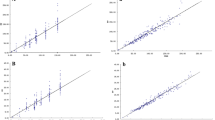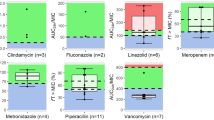Abstract
Objectives
Population pharmacokinetic (popPK) analyses for piperacillin/tazobactam in neonates and infants of less than 2 months of age have been performed by our group previously. The results indicate that a dose of 44.44/5.56 mg/kg piperacillin/tazobactam every 8 or 12 h may not be enough for controlling infection in this population. In order to determine the appropriate dosing regimen and to provide a rationale for the development of dosing guidelines suitable for this population, further popPK studies of piperacillin/tazobactam would need to be conducted. The aim of the present study was to determine the appropriate dosing regimen and optimal sampling schedules in neonates and infants of less than 2 months of age.
Methods
Pharmacodynamic profiling of piperacillin using Monte Carlo simulation was performed to explore the target attainment probability of different dosing regimens for infections caused by different isolated pathogens. D-optimal designs for piperacillin and tazobactam were conducted separately, and the times that overlapped were chosen as the final sampling scheme for future popPK studies in neonates and young infants of less than 2 months of age.
Results
Our findings revealed that compared to the current empirical piperacillin/tazobactam dose regimen (50 mg/kg every 12 h by 5-min infusion in our hospital), the clinical outcome could be improved by increasing doses, increasing administration frequency, and prolonging intravenous infusion in neonates and infants of less than 2 months of age. The following optimal sampling windows were chosen as the final sampling scheme: 0.1–0.11, 0.26–0.29, 0.97–2.62, and 7.95–11.9 h administered every 12 h with 5-min infusion; 0.1–0.12, 0.39–0.56, 2.86–4.95, and 8.91–11.8 h administered every 12 h with 3-h infusion; 0.1–0.11, 0.22–0.29, 0.91–1.96, and 5.56–7.93 h administered every 8 h with 5-min infusion; 0.1–0.11, 0.38–0.48, 2.54–3.82, and 6.86–7.93 h administered every 8 h with 3-h infusion; 0.1–0.11, 0.25–0.28, 0.84–1.69, and 4.55–5.94 h administered every 6 h with 5-min infusion; and 0.1–0.11, 0.37–0.54, 3.13–3.72, and 5.57–5.99 h administered every 6 h with 3-h infusion.
Conclusions
The dosing regimen and sampling schedules proposed in this study should be evaluated in future popPK studies of piperacillin/tazobactam in neonates and infants. To the best of our knowledge, this is the first study that combined optimal sampling design with Monte Carlo simulation for designing popPK studies of piperacillin/tazobactam.


Similar content being viewed by others
References
Federal Drug Administration (2015) Zosyn® (piperacillin and tazobactam for injection). http://www.accessdata.fda.gov/drugsatfda_docs/label/2015/050684s083,050750s033lbl.pdf. Accessed 18 Dec 2015
Flidel-Rimon O, Friedman S, Leibovitz E, Shinwell ES (2006) The use of piperacillin/tazobactam (in association with amikacin) in neonatal sepsis: efficacy and safety data. Scand J Infect Dis 38(1):36–42
Berger A, Kretzer V, Apfalter P, Rohrmeister K, Zaknun D, Pollak A (2004) Safety evaluation of piperacillin/tazobactam in very low birth weight infants. J Chemother 16(2):166–171
Pillay T, Pillay DG, Adhikari M, Sturm AW (1998) Piperacillin/tazobactam in the treatment of Klebsiella pneumoniae infections in neonates. Am J Perinatol 15(1):47–51
Kacet N, Roussel-Delvallez M, Gremillet C, Dubos JP, Storme L, Lequien P (1992) Pharmacokinetic study of piperacillin in newborns relating to gestational and postnatal age. Pediatr Infect Dis J 11(5):365–369
Cohen-Wolkowiez M, Benjamin DK Jr, Ross A, James LP, Sullivan JE, Walsh MC, Zadell A, Newman N, White NR, Kashuba AD, Ouellet D (2012) Population pharmacokinetics of piperacillin using scavenged samples from preterm infants. Ther Drug Monit 34(3):312–319
Cohen-Wolkowiez M, Watt KM, Zhou C, Bloom BT, Poindexter B, Castro L, Gao J, Capparelli EV, Benjamin DK Jr, Smith PB (2014) Developmental pharmacokinetics of piperacillin and tazobactam using plasma and dried blood spots from infants. Antimicrob Agents Chemother 58(5):2856–2865
Li Z, Chen Y, Li Q, Cao D, Shi W, Cao Y, Wu D, Zhu Y, Wang Y, Chen C (2013) Population pharmacokinetics of piperacillin/tazobactam in neonates and young infants. Eur J Clin Pharmacol 69(6):1223–1233
Craig WA (1998) Pharmacokinetic/pharmacodynamic parameters: rationale for antibacterial dosing of mice and men. Clin Infect Dis 26(1):1–10
Lodise TP, Lomaestro BM, Drusano GL, Society of Infectious Diseases Pharmacists (2006) Application of antimicrobial pharmacodynamic concepts into clinical practice: focus on beta-lactam antibiotics: insights from the Society of Infectious Diseases Pharmacists. Pharmacotherapy 26(9):1320–1332
Frei CR, Wiederhold NP, Burgess DS (2008) Antimicrobial breakpoints for gram-negative aerobic bacteria based on pharmacokinetic-pharmacodynamic models with Monte Carlo simulation. J Antimicrob Chemother 61(3):621–628
Roberts JA, Kirkpatrick CM, Lipman J (2011) Monte Carlo simulations: maximizing antibiotic pharmacokinetic data to optimize clinical practice for critically ill patients. J Antimicrob Chemother 66(2):227–231
Salem AH, Zhanel GG, Ibrahim SA, Noreddin AM (2014) Monte Carlo simulation analysis of ceftobiprole, dalbavancin, daptomycin, tigecycline, linezolid and vancomycin pharmacodynamics against intensive care unit-isolated methicillin-resistant Staphylococcus aureus. Clin Exp Pharmacol Physiol 41(6):437–443
Bradley JS, Dudley MN, Drusano GL (2003) Predicting efficacy of antiinfectives with pharmacodynamics and Monte Carlo simulation. Pediatr Infect Dis J 22(11):982–992
Roberts JK, Stockmann C, Balch A, Yu T, Ward RM, Spigarelli MG, Sherwin CM (2015) Optimal design in pediatric pharmacokinetic and pharmacodynamic clinical studies. Paediatr Anaesth 25(3):222–230
Ogungbenro K, Matthews I, Looby M, Kaiser G, Graham G, Aarons L (2009) Population pharmacokinetics and optimal design of paediatric studies for famciclovir. Br J Clin Pharmacol 68(4):546–560
Roos JF, Kirkpatrick CM, Tett SE, McLachlan AJ, Duffull SB (2008) Development of a sufficient design for estimation of fluconazole pharmacokinetics in people with HIV infection. Br J Clin Pharmacol 66(4):455–466
Duffull SB, Retout S, Mentré F (2002) The use of simulated annealing for finding optimal population designs. Comput Methods Prog Biomed 69(1):25–35
Ette EI, Kelman AW, Howie CA, Whiting B (1993) Interpretation of simulation studies for efficient estimation of population pharmacokinetic parameters. Ann Pharmacother 27(9):1034–1039
Li Z, Li Q, Wang Y, Cao D, Chen C (2012) Determination of free and total piperacillin–tazobactam in plasma by HPLC–MS–MS: an adapted method for neonates. Chromatographia 75(75):533–539
Felton TW, Hope WW, Lomaestro BM, Butterfield JM, Kwa AL, Drusano GL, Lodise TP (2012) Population pharmacokinetics of extended-infusion piperacillin-tazobactam in hospitalized patients with nosocomial infections. Antimicrob Agents Chemother 56(8):4087–4094
Roberts JA, Kirkpatrick CM, Roberts MS, Dalley AJ, Lipman J (2010) First-dose and steady-state population pharmacokinetics and pharmacodynamics of piperacillin by continuous or intermittent dosing in critically ill patients with sepsis. Int J Antimicrob Agents 35(2):156–163
Shea KM, Cheatham SC, Smith DW, Wack MF, Sowinski KM, Kays MB (2009) Comparative pharmacodynamics of intermittent and prolonged infusions of piperacillin/tazobactam using Monte Carlo simulations and steady-state pharmacokinetic data from hospitalized patients. Ann Pharmacother 43(11):1747–1754
European Medicines Agency (2007) Guideline on the investigation of medicinal products in the term and preterm neonate. http://www.ema.europa.eu/docs/en_GB/document_library/Scientific_guideline/2009/09/WC500003754.pdf. Accessed Oct 2007
Di Giovamberardino G, Ferrannini M, Testore GP, Federici G, Pastore A (2009) High performance liquid chromatographic determination of plasma free and total tazobactam and piperacillin. J Chromatogr B Analyt Technol Biomed Life Sci 877(1–2):86–88
Food and Drug Administration (1999) Guidance for industry population pharmacokinetics. http://www.fda.gov/downloads/scienceresearch/specialtopics/womenshealthresearch/ucm133184.pdf. Accessed Feb 1999
Acknowledgments
The authors would like to thank Alexander A. Vinks for providing valuable edits and comments to our resubmission. All authors read and approved the final manuscript.
Author information
Authors and Affiliations
Corresponding author
Electronic supplementary material
ESM 1
(DOCX 17 kb)
Rights and permissions
About this article
Cite this article
Chen, Y., Lu, J., Dong, M. et al. Target attainment analysis and optimal sampling designs for population pharmacokinetic study on piperacillin/tazobactam in neonates and young infants. Eur J Clin Pharmacol 72, 1479–1488 (2016). https://doi.org/10.1007/s00228-016-2131-0
Received:
Accepted:
Published:
Issue Date:
DOI: https://doi.org/10.1007/s00228-016-2131-0




